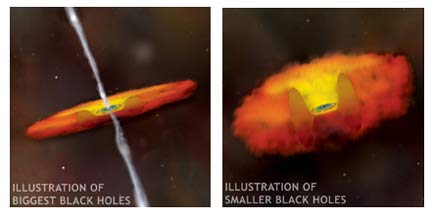UH scientists find
size limit to black holes
X-ray studies reveal two growth
patterns for huge gravity wells
Bingeing on meals of gas and dust during the early formation of the universe led to the stagnation of the biggest black holes, University of Hawaii astronomers have discovered.
Black holes with at least 100 million times the mass of the sun ran out of "food" and stopped growing billions of years ago, they said.
"Most massive black holes, ones at a great distance early in the universe, seem to stop accreting matter at some point and reach a weight limit," astronomer Amy Barger said in an interview. "Meanwhile, other black holes, ones that are obscured, have not stopped accreting and are still growing."

Black holes with masses greater than 100 million suns, left, grow quickly but then stop, perhaps because powerful jets generated by the feeding frenzy clear away any remaining fuel. Smaller black holes, right, grow slowly and steadily.
A black hole is a dense, compact object whose gravitational pull is so strong that -- within a certain distance of it -- nothing can escape, not even light.
One revelation is that there is a strong connection between the growth of black holes and the birth of stars. Previously, astronomers had done careful studies of the birth rate of stars in galaxies but did not know as much about the black holes at their centers.
"Star formation probably follows a black hole," Barger said. As stars form, material falls into the black hole, which contributes to its growth, she said.
The findings were reported in the February issue of the Astronomical Journal by a group led by Barger.
Barger and Cowie have worked for years with data from the orbiting Chandra X-ray Observatory.
"The discovery of these black holes that aren't accreting so greedily as distant quasars (dormant black holes) -- that was a great surprise that they exist at all and that they exist at more recent times."
The universe is about 13.5 billion years old, so "recent times" are about 6 or 7 billion years ago.
Just before material falls into a black hole, it radiates energy in all wavelengths and particularly the X-ray wavelength, Barger said.
Chandra's images expose hidden black holes because X-rays penetrate the gas and dust that normally block optical and ultraviolet emissions.
"A lot of these black holes are obscured, with lots of dust and gas around them, where light doesn't escape," Barger said.
Before, she said, they had just single pointings with the Chandra Observatory camera. This time, they had nine contiguous pointings, giving them nine times the area studied in the past, giving them more chances to detect rare objects, she said.
"Importantly for this study, we were able to observe a large number of sources at more recent times, half the age of the universe. We can understand how they work much better."
Additional research during the past five years with the telescopes and optical imaging of galaxies contributed more information to the understanding of super-massive black holes, Barger said.
"Because it's such a large area, it takes a long time to follow up all sources and determine distances. The Hubble Space Telescope also had a new instrument that observed sources in the Hubble deep field and gave us information about emissions from the black-hole region."
[News] [Business] [Features] [Sports] [Editorial] [Do It Electric!]
[Classified Ads] [Search] [Subscribe] [Info] [Letter to Editor]
[Feedback]
